Art in the Park
Explore the eight installations that make up Hermann Park's Centennial Art Project, Art in the Park. On this tour you'll view site-specific works, temporary loans, and even a permanent installation in the train tunnel that can only be accessed by riding the Hermann Park Railroad. This tour will give you an opporunity to see different parts of the Park that you may not have explored before. Most of these works are only on view in the Park for one year or less so see them before they leave in 2015. Enjoy!
STOP 1.
BOOGIE WOOGIE BY PATRICK DOUGHERTY
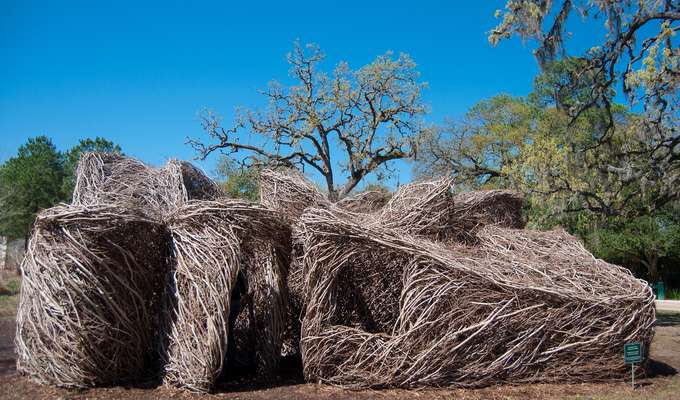
Patrick Dougherty and a team of Hermann Park Conservancy volunteers constructed this site-specific installation, Boogie Woogie, in Hermann Park using saplings gathered from Generation Park, a master-planned enterprise development in northeast Houston. Volunteers worked under the close direction of the artist over the course of three weeks in January of 2014 to build the sculpture. The project required over 150 volunteers and more than 1,000 volunteer hours to complete.
For more information, please visit the Art in the Park section.
STOP 2.
DESTINATION MOUND TOWN (TRAIN TUNNEL) BY TRENTON DOYLE HANCOCK
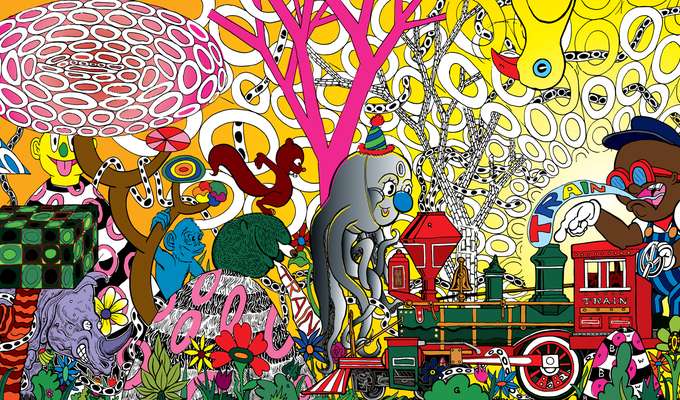
Trenton Doyle Hancock, a Houston-based artist, has transformed the interior walls of the Hermann Park Railroad train tunnel into a fantastical landscape populated with creatures both real and imagined. Destination Mound Town is a contribution to Hancock's ongoing narrative in his artwork of the Mounds, a group of mythical half-animal, half-plant characters. Train passengers are transported into a day in the life of the Mounds, beginning the journey as they arise in morning and exiting the tunnel as they settle in for the night.
Please note: there is no safe pedestrian access into the train tunnel. The work is only visible by train.
For more information, please visit the Art in the Park section.
STOP 3.
WIND WAVES BY YVONNE DOMENGE
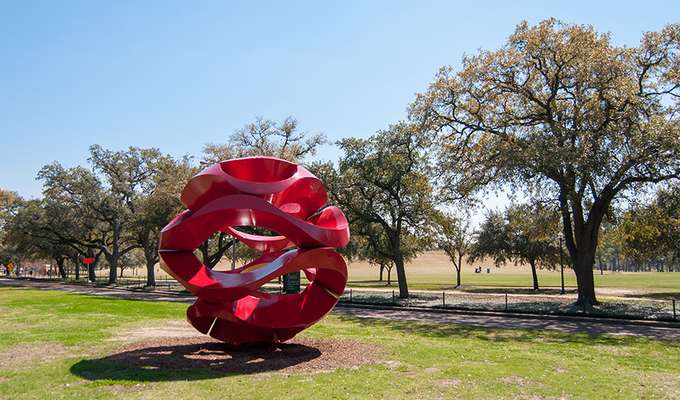
Wind Waves, by Mexican artist Yvonne Domenge, is a thirteen-foot tall Ferrari-red steel orb weighing close to 6 tons. The sculpture draws on organic, curvilinear forms and, like most of her work, is influenced by mathematics, physics, the natural world, and the traditional art of Mexico. Her artwork has been exhibited widely internationally, and was recently exhibited at Millennium Park in Chicago and in the Vancouver Biennale.
For more information, please visit the Art in the Park section.
STOP 4.
BOYS CRY TOO BY ORLY GENGER
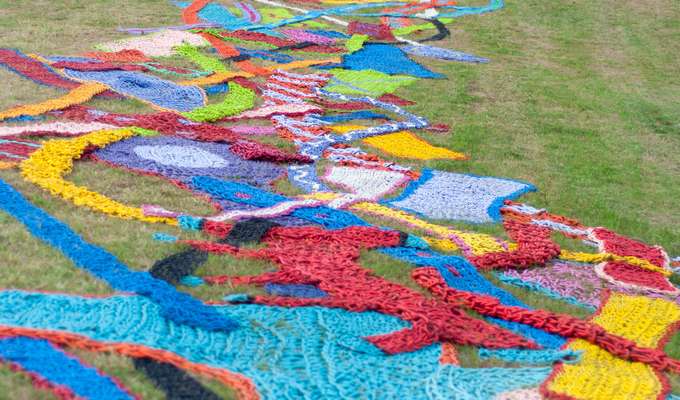
New York-based artist, Orly Genger, re-imagined a previous work for Hermann Park’s landscaping alongside Brays Bayou. An emerging talent, Genger has garnered attention for her large-scale constructions of brightly painted, knotted nautical rope. Spanning the genres of craft and fine art, Genger mines the intimate, domestic, and traditionally feminine practice of knitting to create sprawling, monumental installations. Genger’s Boys Cry Too lies directly on the grass and measures 225 feet long and 17 feet wide. Boys Cry Too is painted in a wide range of colors including Eggnog, Springtime Bloom, and Limeade. Boys Cry Too will be on view until March 2015.
For more information, please visit the Art in the Park section.
STOP 5.
DILLIDIIDAE BY SHARON ENGELSTEIN
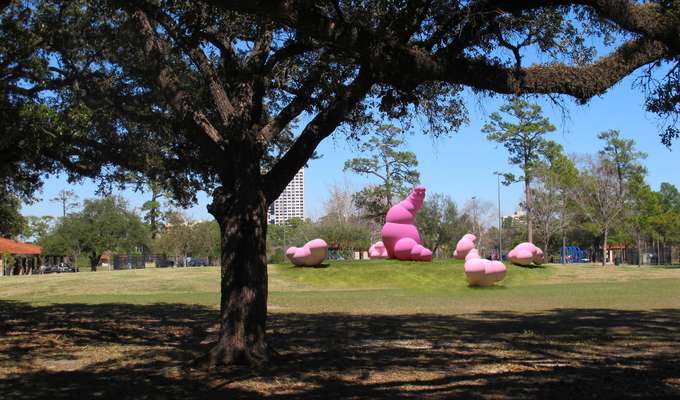
A former Core Fellow and a resident of Houston for many years, Sharon Engelstein is known for her organic, bubbly sculptural forms. For Hermann Park, Engelstein designed one taller element, Mamadillidiidae, poised on the site surrounded by several smaller pieces called Dillidiidae. These “wandering” forms are not immediately recognizable as identical quintuplets but will appear to be quite different in their various positions on the knoll. The tumbling forms invite interactivity and draw visitors due to their vibrant hues.
Dillidiidae will be on view through April 2017.
For more information, please visit the Art in the Park section.
STOP 6.
SPIDER BY LOUISE BOURGEOIS
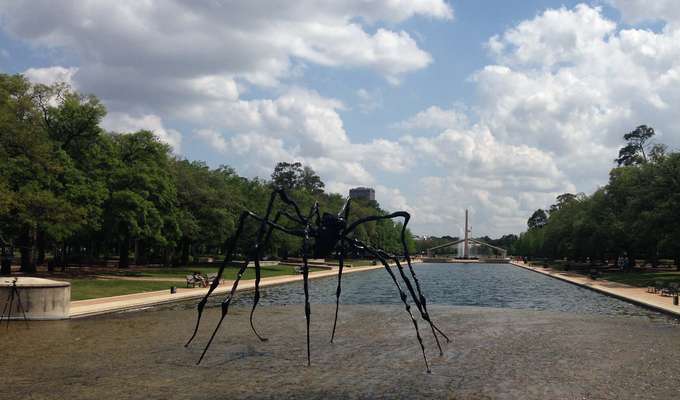
Spider, a monumental bronze sculpture by internationally-acclaimed artist, Louise Bourgeois, appears to be floating in the middle of the Jones Reflection Pool. Beginning in 1984 until her death in 2010, Bourgeois developed a rich body of work around the spider, from delicate works on paper to colossal installations. From a family of weavers, Bourgeois employs the spider as a maternal figure: looming, protective, and nurturing.
The spider will be on view in the Jones Reflection Pool through July 8, 2014.
For more information, please visit the Art in the Park section.
STOP 7.
UNIVERSITY OF HOUSTON MICRO PAVILION: REFRAME X FRAME
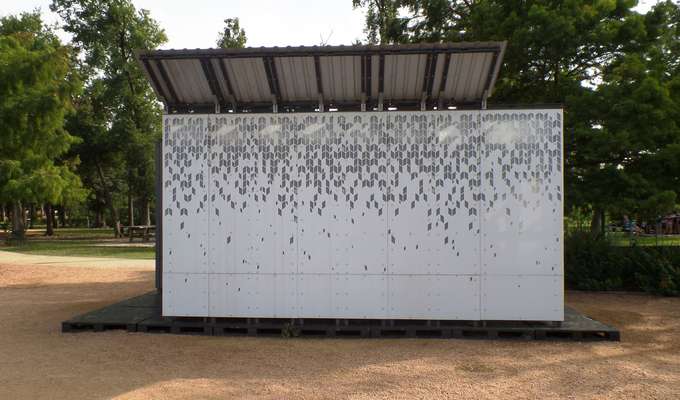
The project is a collaboration between professors in the University of Houston Graduate Design/Build Studio in the College of Architecture, the Graphic Communications Program in the School of Art, and the Cynthia Woods Mitchell Center for the Arts. It proposes the development of a semi-permanent open-air installation within a public park environment. This project demonstrates the principles of sustainable design and construction through the use of Allsteel System frames as prefabricated deployable building systems that can be applicable in disaster relief settings. The structure will be located on the north side of the Tiffany Bridge, and will incorporate lighted elements on one exterior wall, along with an information panel.
Within the structure, artist Abinadi Meza will create a motion-triggered sound installation based on environmental data. The "ambient/sonic/weather station" is a generative/interactive sound installation based on various data streams of the city/environment, such as air temperature, humidity, soil temperature, barometric pressure, animal and plant movements, flowing waterways, etc. These sounds emanate from the structure as bleeps, roars, whirrs, blips, hisses, cracks and shuffles, allowing visitors to focus on layers of information we don't normally hear, as ephemeral phenomena such as light or heat are generating the sounds.
The pavilion will be on view March 2014 - January 2015.
STOP 8.
Rice University Convergence
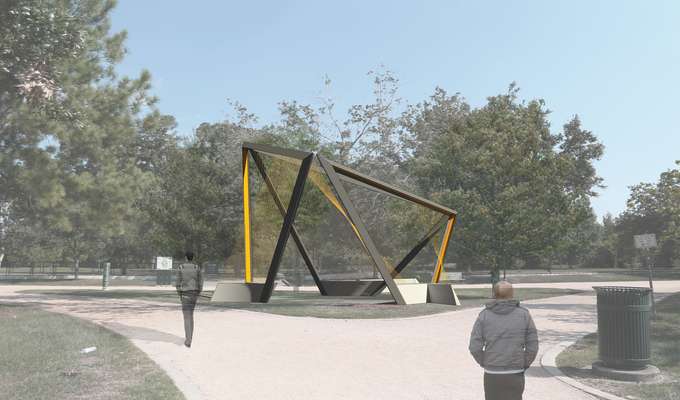
Hermann Park, Rice University, and The Texas Medical Center have shared a long neighboring relationship in Houston. Their paths come together at a small triangular site where the Rice Building Workshop erected a pavilion in honor of the Park’s Centennial Celebration.
Situated within four existing trees, the pavilion is composed of a quadrilateral ground plane containing integrated benches and, rotated above the base, a triangular frame. The cast concrete benches for seating are engineered to act as foundation elements (taking the place of costly and invasive footings). The triangulated steel structure is designed to provide a rigid framework and to visually extend into the lower tree canopy. The infill of woven cord gives a sense of enclosure and operates as an ephemeral scrim to the larger site beyond.
The project as a whole offers a rich collaboration between Rice University School of Architecture and the Hermann Park Conservancy. Students in the Rice Building Workshop succeeded in transforming a design idea into a built project that will be enjoyed by the Houston community over the year-long installation at Hermann Park. After the installation, the building components can be re-assembled at a site on the Rice campus.
The pavilion will be on view through February 2015.